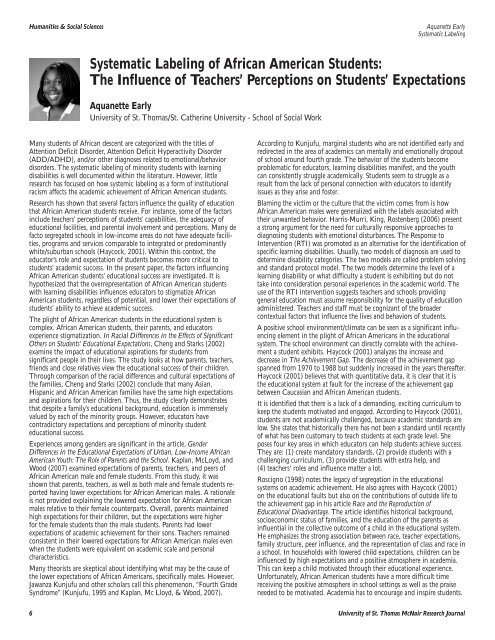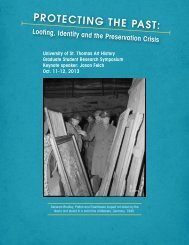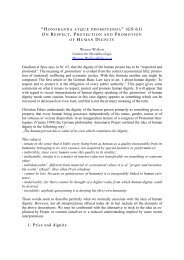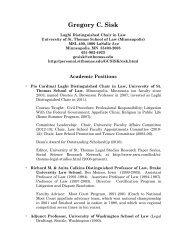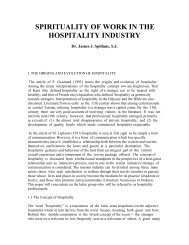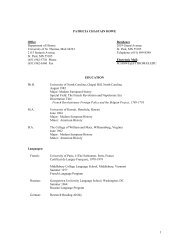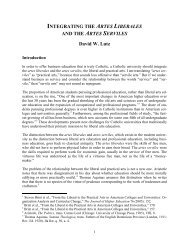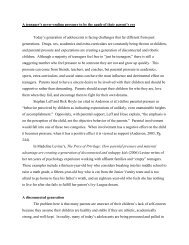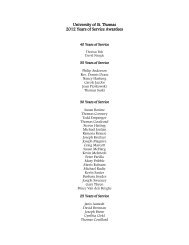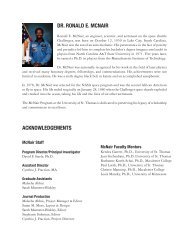McNair Research Journal - University of St. Thomas
McNair Research Journal - University of St. Thomas
McNair Research Journal - University of St. Thomas
You also want an ePaper? Increase the reach of your titles
YUMPU automatically turns print PDFs into web optimized ePapers that Google loves.
Humanities & Social Sciences<br />
Many students <strong>of</strong> African descent are categorized with the titles <strong>of</strong><br />
Attention Deficit Disorder, Attention Deficit Hyperactivity Disorder<br />
(ADD/ADHD), and/or other diagnoses related to emotional/behavior<br />
disorders. The systematic labeling <strong>of</strong> minority students with learning<br />
disabilities is well documented within the literature. However, little<br />
research has focused on how systemic labeling as a form <strong>of</strong> institutional<br />
racism affects the academic achievement <strong>of</strong> African American students.<br />
<strong>Research</strong> has shown that several factors influence the quality <strong>of</strong> education<br />
that African American students receive. For instance, some <strong>of</strong> the factors<br />
include teachers’ perceptions <strong>of</strong> students’ capabilities, the adequacy <strong>of</strong><br />
educational facilities, and parental involvement and perceptions. Many de<br />
facto segregated schools in low-income areas do not have adequate facilities,<br />
programs and services comparable to integrated or predominantly<br />
white/suburban schools (Haycock, 2001). Within this context, the<br />
educator’s role and expectation <strong>of</strong> students becomes more critical to<br />
students’ academic success. In the present paper, the factors influencing<br />
African American students’ educational success are investigated. It is<br />
hypothesized that the overrepresentation <strong>of</strong> African American students<br />
with learning disabilities influences educators to stigmatize African<br />
American students, regardless <strong>of</strong> potential, and lower their expectations <strong>of</strong><br />
students’ ability to achieve academic success.<br />
The plight <strong>of</strong> African American students in the educational system is<br />
complex. African American students, their parents, and educators<br />
experience stigmatization. In Racial Differences in the Effects <strong>of</strong> Significant<br />
Others on <strong>St</strong>udents' Educational Expectations, Cheng and <strong>St</strong>arks (2002)<br />
examine the impact <strong>of</strong> educational aspirations for students from<br />
significant people in their lives. The study looks at how parents, teachers,<br />
friends and close relatives view the educational success <strong>of</strong> their children.<br />
Through comparison <strong>of</strong> the racial differences and cultural expectations <strong>of</strong><br />
the families, Cheng and <strong>St</strong>arks (2002) conclude that many Asian,<br />
Hispanic and African American families have the same high expectations<br />
and aspirations for their children. Thus, the study clearly demonstrates<br />
that despite a family’s educational background, education is immensely<br />
valued by each <strong>of</strong> the minority groups. However, educators have<br />
contradictory expectations and perceptions <strong>of</strong> minority student<br />
educational success.<br />
Experiences among genders are significant in the article, Gender<br />
Differences in the Educational Expectations <strong>of</strong> Urban, Low-Income African<br />
American Youth: The Role <strong>of</strong> Parents and the School. Kaplan, McLoyd, and<br />
Wood (2007) examined expectations <strong>of</strong> parents, teachers, and peers <strong>of</strong><br />
African American male and female students. From this study, it was<br />
shown that parents, teachers, as well as both male and female students reported<br />
having lower expectations for African American males. A rationale<br />
is not provided explaining the lowered expectation for African American<br />
males relative to their female counterparts. Overall, parents maintained<br />
high expectations for their children, but the expectations were higher<br />
for the female students than the male students. Parents had lower<br />
expectations <strong>of</strong> academic achievement for their sons. Teachers remained<br />
consistent in their lowered expectations for African American males even<br />
when the students were equivalent on academic scale and personal<br />
characteristics.<br />
Many theorists are skeptical about identifying what may be the cause <strong>of</strong><br />
the lower expectations <strong>of</strong> African Americans, specifically males. However,<br />
Jawanza Kunjufu and other scholars call this phenomenon, “Fourth Grade<br />
Syndrome” (Kunjufu, 1995 and Kaplan, Mc Lloyd, & Wood, 2007).<br />
Aquanette Early<br />
Systematic Labeling<br />
Systematic Labeling <strong>of</strong> African American <strong>St</strong>udents:<br />
The Influence <strong>of</strong> Teachers’ Perceptions on <strong>St</strong>udents’ Expectations<br />
Aquanette Early<br />
<strong>University</strong> <strong>of</strong> <strong>St</strong>. <strong>Thomas</strong>/<strong>St</strong>. Catherine <strong>University</strong> - School <strong>of</strong> Social Work<br />
According to Kunjufu, marginal students who are not identified early and<br />
redirected in the area <strong>of</strong> academics can mentally and emotionally dropout<br />
<strong>of</strong> school around fourth grade. The behavior <strong>of</strong> the students become<br />
problematic for educators, learning disabilities manifest, and the youth<br />
can consistently struggle academically. <strong>St</strong>udents seem to struggle as a<br />
result from the lack <strong>of</strong> personal connection with educators to identify<br />
issues as they arise and foster.<br />
Blaming the victim or the culture that the victim comes from is how<br />
African American males were generalized with the labels associated with<br />
their unwanted behavior. Harris-Murri, King, Rostenberg (2006) present<br />
a strong argument for the need for culturally responsive approaches to<br />
diagnosing students with emotional disturbances. The Response to<br />
Intervention (RTI) was promoted as an alternative for the identification <strong>of</strong><br />
specific learning disabilities. Usually, two models <strong>of</strong> diagnosis are used to<br />
determine disability categories. The two models are called problem solving<br />
and standard protocol model. The two models determine the level <strong>of</strong> a<br />
learning disability or what difficulty a student is exhibiting but do not<br />
take into consideration personal experiences in the academic world. The<br />
use <strong>of</strong> the RTI intervention suggests teachers and schools providing<br />
general education must assume responsibility for the quality <strong>of</strong> education<br />
administered. Teachers and staff must be cognizant <strong>of</strong> the broader<br />
contextual factors that influence the lives and behaviors <strong>of</strong> students.<br />
A positive school environment/climate can be seen as a significant influencing<br />
element in the plight <strong>of</strong> African Americans in the educational<br />
system. The school environment can directly correlate with the achievement<br />
a student exhibits. Haycock (2001) analyzes the increase and<br />
decrease in The Achievement Gap. The decrease <strong>of</strong> the achievement gap<br />
spanned from 1970 to 1988 but suddenly increased in the years thereafter.<br />
Haycock (2001) believes that with quantitative data, it is clear that it is<br />
the educational system at fault for the increase <strong>of</strong> the achievement gap<br />
between Caucasian and African American students.<br />
It is identified that there is a lack <strong>of</strong> a demanding, exciting curriculum to<br />
keep the students motivated and engaged. According to Haycock (2001),<br />
students are not academically challenged, because academic standards are<br />
low. She states that historically there has not been a standard until recently<br />
<strong>of</strong> what has been customary to teach students at each grade level. She<br />
poses four key areas in which educators can help students achieve success.<br />
They are: (1) create mandatory standards, (2) provide students with a<br />
challenging curriculum, (3) provide students with extra help, and<br />
(4) teachers' roles and influence matter a lot.<br />
Roscigno (1998) notes the legacy <strong>of</strong> segregation in the educational<br />
systems on academic achievement. He also agrees with Haycock (2001)<br />
on the educational faults but also on the contributions <strong>of</strong> outside life to<br />
the achievement gap in his article Race and the Reproduction <strong>of</strong><br />
Educational Disadvantage. The article identifies historical background,<br />
socioeconomic status <strong>of</strong> families, and the education <strong>of</strong> the parents as<br />
influential in the collective outcome <strong>of</strong> a child in the educational system.<br />
He emphasizes the strong association between race, teacher expectations,<br />
family structure, peer influence, and the representation <strong>of</strong> class and race in<br />
a school. In households with lowered child expectations, children can be<br />
influenced by high expectations and a positive atmosphere in academia.<br />
This can keep a child motivated through their educational experience.<br />
Unfortunately, African American students have a more difficult time<br />
receiving the positive atmosphere in school settings as well as the praise<br />
needed to be motivated. Academia has to encourage and inspire students.<br />
6 <strong>University</strong> <strong>of</strong> <strong>St</strong>. <strong>Thomas</strong> <strong>McNair</strong> <strong>Research</strong> <strong>Journal</strong>


